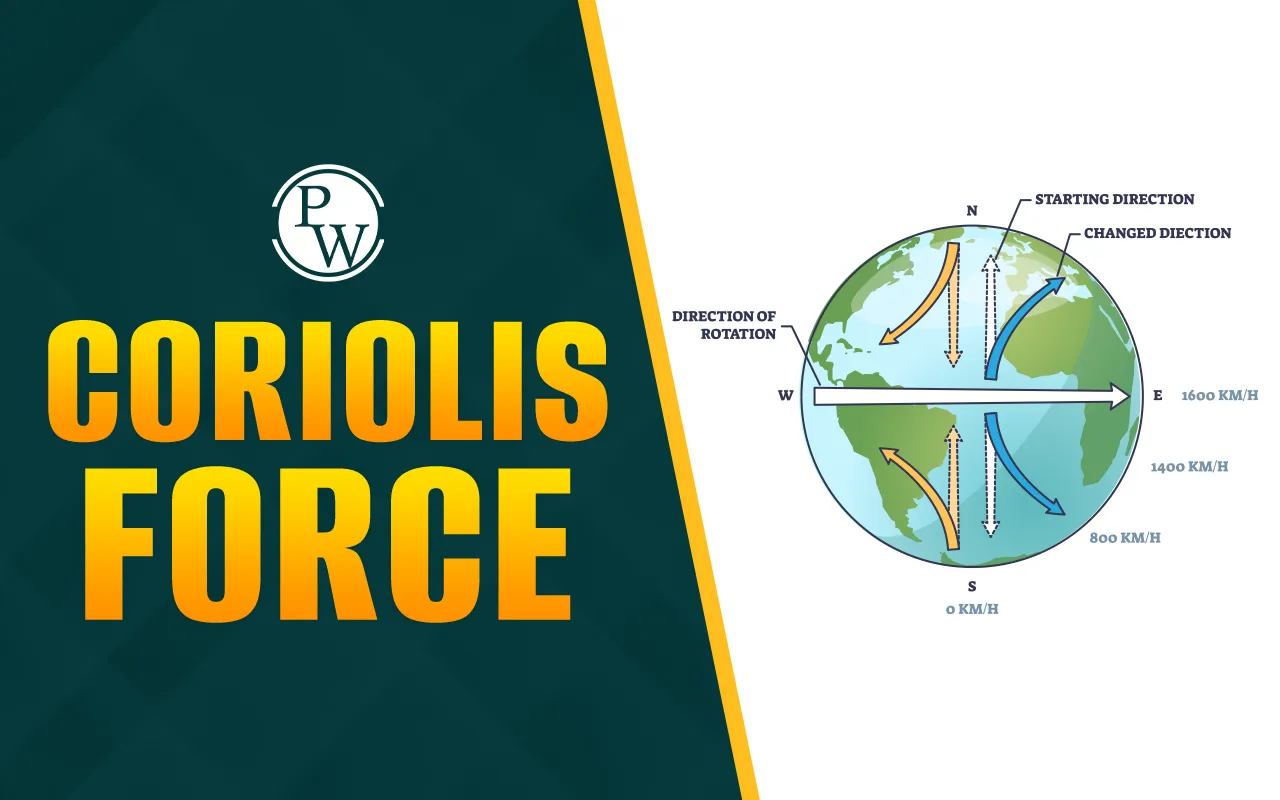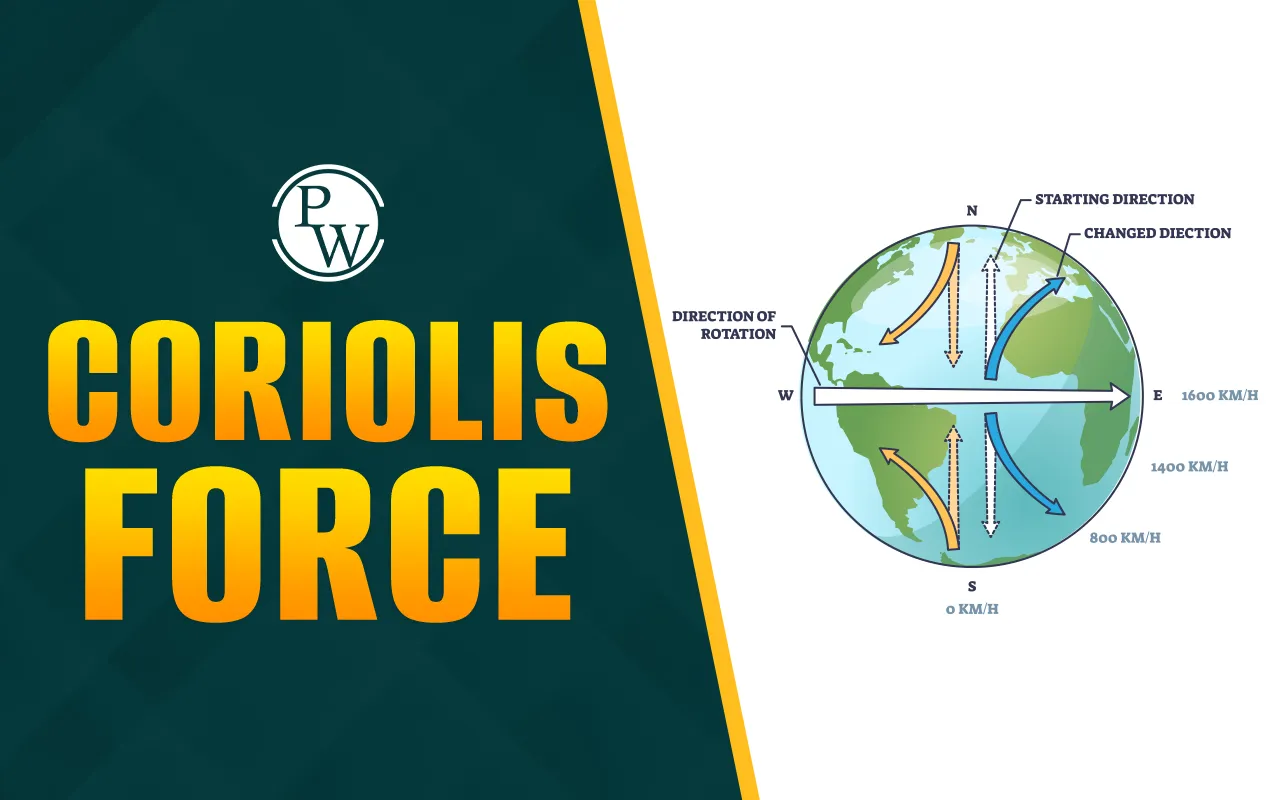

Coriolis force is an apparent force that arises due to the rotation of the Earth. It affects the motion of objects moving over the surface, causing them to deflect to the right in the Northern Hemisphere and to the left in the Southern Hemisphere.
This force plays a crucial role in shaping weather patterns, ocean currents, and large-scale atmospheric movements.
What is Coriolis Force?
The Coriolis Force is defined as an apparent or fictitious force that seems to act on objects moving across a rotating surface, such as the Earth. It is not a real pushing or pulling force like gravity, but rather a perceived effect that occurs because the observer is also rotating along with the Earth.
|
Coriolis Force |
|
|
Aspect |
Explanation |
|
Definition |
An apparent force that makes the path of moving objects appear deflected in a rotating system. |
|
Cause |
It arises due to the Earth's rotation on its axis. |
|
Mechanism |
The surface beneath the object is constantly moving, causing the object's straight path to look curved from the Earth’s surface. |
|
Alternate Name |
It is sometimes called a fictitious or apparent force. |
Direction of Deflection
The rotation of the Earth causes objects to deflect in specific ways, depending on their location:
-
Northern Hemisphere: Objects (like winds or currents) are deflected to the right of their direction of motion.
-
Southern Hemisphere: Objects are deflected to the left of their direction of motion.
Coriolis Force vs. Coriolis Effect
While often used interchangeably, the Coriolis Force and the Coriolis Effect describe two slightly different aspects of the same phenomenon.
-
Coriolis Force: This is the imaginary force itself that arises because we are observing motion from a rotating reference frame (the Earth). It is the concept used in mathematical equations.
-
Coriolis Effect: This is the observable outcome or result of the force. It is the apparent curving of the path of a moving object, like winds or ocean currents, bending away from a straight line.
Factors Affecting the Coriolis Force
The strength of the Coriolis Force is not uniform across the globe; it depends on certain geographical and physical factors:
|
Factors Affecting the Coriolis Force |
||
|
Factor |
Effect on Coriolis Force |
Explanation |
|
Latitude |
Strongest at the Poles, Zero at the Equator |
At the Equator, there is no deflection, making the force zero. As an object moves closer to the North or South Pole, the rotational effect becomes greater, making the force stronger. |
|
Speed of Object |
Increases with Speed |
Objects that move faster (like jet streams or missiles) experience a greater degree of deflection than slower-moving objects (like surface ocean currents). |
|
Direction of Motion |
Changes Direction, Not Speed |
The Coriolis Force acts at right angles to the movement of the object. Therefore, it only changes the direction in which the object is moving, but not its velocity or speed. |
Impact of Coriolis Force on Global Systems
The Coriolis Effect plays a crucial role in shaping the planet's atmospheric and oceanic movements.
1. Influence on Global Wind Patterns
The Coriolis Force is one of the main components that determines global wind circulation. Winds are generated by the movement of air from areas of High Pressure to areas of Low Pressure (Pressure Gradient Force). The Coriolis Force then deflects this moving air, creating major planetary wind systems like the Trade Winds and Westerlies.
2. Formation and Rotation of Cyclones
-
The rotation of large storm systems, such as hurricanes and cyclones, is a direct result of the Coriolis Effect.
-
In the Northern Hemisphere, the deflection to the right causes cyclones to rotate counterclockwise.
-
In the Southern Hemisphere, the deflection to the left causes cyclones to rotate clockwise.
3. Impact on Ocean Currents
Similar to winds, large ocean currents are also deflected by the Coriolis Force. This deflection is vital in shaping the global ocean circulation patterns (known as gyres), which in turn influence coastal and global climates.
4. Geostrophic Wind
At high altitudes, where the influence of friction from the Earth's surface is negligible, the Coriolis Force can be perfectly balanced by the Pressure Gradient Force. When this happens, the resulting wind flows parallel to the lines of equal pressure (isobars) and is known as the Geostrophic Wind.
Coriolis Force FAQs
Who first explained the concept of Coriolis Force?
Why is the Coriolis Force zero at the Equator?
Does the Coriolis Force affect the draining of water in a sink?
Does the Coriolis Force affect the speed of an object?

UPSC Coaching










